► Off roading in the UK
► Expert advice from a professional
► Learning the ropes in a Jeep Wrangler
Want to learn how to drive off-road like a pro? We’ve enlisted the help of an expert to give us some advice and guidance for novices looking to get into off-road driving.
There are loads of places you can go off-roading in the UK, including specific courses designed to test your car’s mettle and hone your skills.
We’ve called upon the specialists at Protrax on how to teach us the basics, using a Jeep Wrangler formerly on CAR’s long-term test fleet. Protrax offers training for Jeep owners, giving them the full run-down of every bit of off-road technology, and guidance on how to make the best use of it. Want to get in on the action yourself? All levels of experience are welcome, and so are other vehicles ranging from Land Rovers to quads.
Find out more about Protrax here
Let’s get started!
Bringing CAR’s long-term Wrangler to an off-road course is a bit like a parent taking their kid to a theme park. The little one is itching to try it all, while the daunted parent wants to get through the day without incident. Luckily, I have a fantastic teacher: Edd Cobley (below), a three-time Defender Rally champion and stunt driver.

Read our archived reports on living with a Jeep Wrangler by signing up to be a CAR Member
‘Before you do anything, knowing your vehicle is absolutely critical,’ Cobley tells me. ‘You want to check fluid levels and make sure the vehicle is maintained appropriately.’ I’m already there: our Wrangler Rubicon is frankly a little too pampered under my watch.
Getting familiar with your car includes knowing exactly what every button and lever allows you to do on challenging terrain. ‘Interestingly, your four-wheel-drive system is the most complex system in the world,’ Cobley laughs, noting that some of the complexity isn’t strictly necessary; the secondary shifter’s 4H Auto and 4H Part-Time modes are pretty much the same.
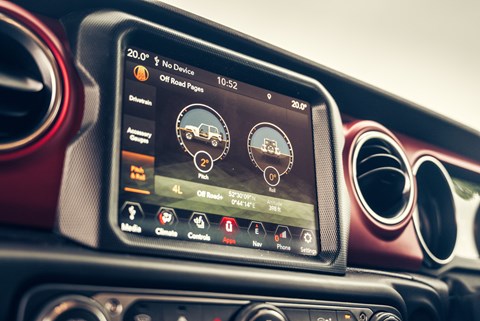
A lot of off-road success is down to the driver, not the car. ‘Best practice for any off-roading is using both hands with your thumbs out, and always maintaining a firm grip of the wheel,’ Cobley says as we get rolling.
We start with a steep descent to test out the Wrangler’s hill descent control, which allows such finite control that the lowest speed setting is 0.6mph.
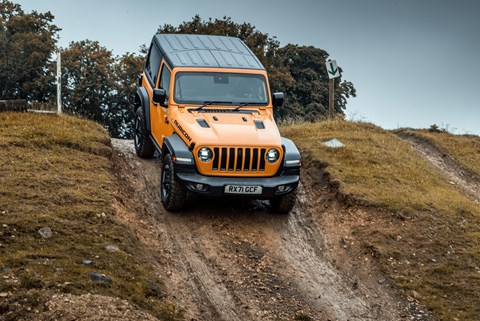
After lining up the descent using the Jeep’s bonnet corners (finally, a reason to be glad that the slabby hood is visible all the time) and creeping blind over the brow of the hill, the Wrangler groans as it cadence brakes itself down the steep decline, while Cobley teaches me to steer into any dips to maintain grip at all times. Easy peasy.
Chaotic cambers and wading
Then he decides to stretch my ability on a track with a severe camber. ‘This is one of the most dangerous activities you can do off-road,’ he says. ‘You can make the vehicle roll over on this side traverse.’ The angle is severe but the technique is the same: have a good look to assess your options, and rather than fighting the laws of physics allow the Jeep to find places for the wheels to rest.

Creeping forward and feeling the car tilt, I’m convinced it’s going to roll; at its most extreme angle, my head is almost touching the passenger-seat headrest.
The next obstacle comes in the shape of wading through a deep ford. Before even attempting to wade through deep water, Cobley recommends checking the maximum wading depth of your vehicle. He also advises keeping a broom handle in your car; doing so allows you to check the depth and compare it to the height of your car.
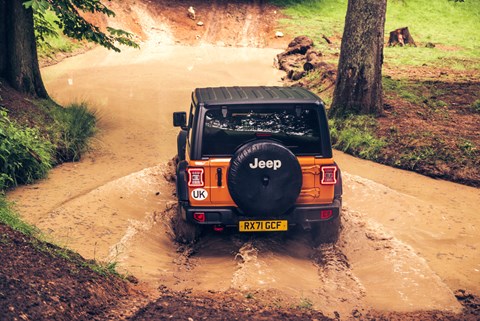
On approach, the key is consistency. Stop at the entry point and find where you’re going to exit the ford. Maintain a laser focus on that exit point and accelerate. Maintain level of acceleration and don’t lose your nerve.
Watch: CAR’s long-term Jeep Wrangler battles the Ford Bronco off-road
Extreme articulation
The biggest obstacle lies ahead, testing the Rubicon’s wheel articulation to its limits. ‘One of the big things with older Jeeps is they never could manage significant articulation, and if you wanted to detach the sway bar you needed spanners.’
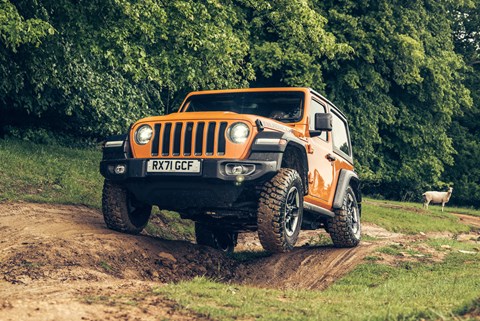
Not here, though, as the Rubicon’s electronically-detachable front roll bar is pressed into service. We start simple with some flat-level wheel articulation so I can get used to the Jeep tilting from side to side and work the axle differentials, but then the big one: a deeply rutted track that runs downhill.
On approach, Cobley makes me hold as we teeter on two wheels. The Wrangler’s short wheelbase – a boon for steep hills – could work against it here. If I make the wrong move, the Wrangler could roll over.
I hold my breath and slowly release the brake, the torque moving the Wrangler forward. It’s heart-stopping stuff from behind the wheel as the Wrangler violently tips forward. BANG! ‘Go, go go!’ Giving it some gas gets the Jeep out of the ruts and onto solid ground.
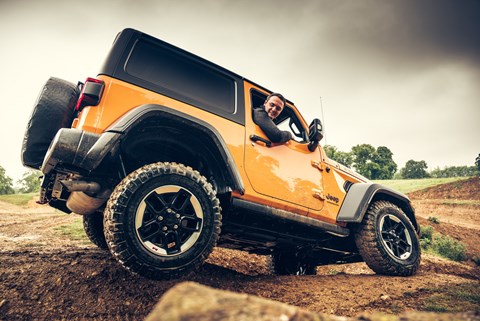
‘Beautifully done,’ says Edd, which makes my day. While I’ve learned loads, I’m also happy I haven’t tipped over a £55k 4×4 with me and him inside it.
Cobley gives me one last bit of advice: ‘If in doubt, get out of the situation. Never ever be afraid to stop and reverse out of an obstacle, even if you’re in maximum capability in water. It’s just not worth pushing it if you don’t feel comfortable.’